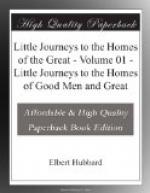Dear old M. Taine, ever glad to score a point against the British, and willing to take Dickens at his word, says, “We have no such men in France as Scrooge and Squeers!”
But, God bless you, M. Taine, England has no such men either.
The novelist takes the men and women he has known, and from life, plus imagination, he creates. If he sticks too close to nature he describes, not depicts: this is “veritism.” If imagination’s wing is too strong, it lifts the luckless writer off from earth and carries him to an unknown land. You may then fall down and worship his characters, and there is no violation of the First Commandment.
Nothing can be imagined that has not been seen; but imagination can assort, omit, sift, select, construct. Given a horse, an eagle, an elephant, and the “creative artist” can make an animal that is neither a horse, an eagle, nor an elephant, yet resembles each. This animal may have eight legs (or forty) with hoofs, claws and toes alternating; a beak, a trunk, a mane; and the whole can be feathered and given the power of rapid flight and also the ability to run like the East Wind. It can neigh, roar or scream by turn, or can do all in concert, with a vibratory force multiplied by one thousand.
The novelist must have lived, and the novelist must have imagination. But this is not enough. He must have power to analyze and separate, and then he should have the good taste to select and group, forming his parts into a harmonious whole.
Yet he must build large. Life-size will not do: the statue must be heroic, and the artist’s genius must breathe into its nostrils the breath of life.
The men who live in history are those whose lives have been skilfully written. “Plutarch is the most charming writer of fiction the world has ever known,” said Emerson.
Dickens’ characters are personifications of traits, not men and women. Yet they are a deal funnier—they are as funny as a box of monkeys, as entertaining as a Punch-and-Judy show, as interesting as a “fifteen puzzle,” and sometimes as pretty as chromos. Quilp munching the eggs, shells and all, to scare his wife, makes one shiver as though a Jack-in-the-box had been popped out at him. Mr. Mould, the undertaker, and Jaggers, the lawyer, are as amusing as Humpty-Dumpty and Pantaloon. I am sure that no live lawyer ever gave me half the enjoyment that Jaggers has, and Doctor Slammers’ talk is better medicine than the pills of any living M.D. Because the burnt-cork minstrel pleases me more than a real “nigger” is no reason why I should find fault!
Dickens takes the horse, the eagle and the elephant and makes an animal of his own. He rubs up the feathers, places the tail at a fierce angle, makes the glass eyes glare, and you are ready to swear that the thing is alive.
By rummaging over the commercial world you can collect the harshness, greed, avarice, selfishness and vanity from a thousand men. With these sins you can, if you are very skilful, construct a Ralph Nickleby, a Scrooge, a Jonas Chuzzlewit, an Alderman Cute, a Mr. Murdstone, a Bounderby or a Gradgrind at will.




